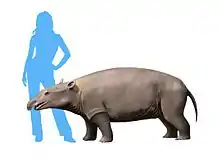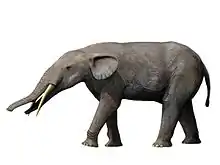Stegodontidae
Stegodontidae is an extinct family of Stegodon-like proboscideans that was endemic to Africa and Asia from the Miocene (15.97 mya)[1] to the Late Pleistocene, with some studies suggesting that some survived into the Holocene in China (until as recently as 4.1 thousand years ago),[2] although this is disputed.[3]
| Stegodontidae | |
|---|---|
| Scientific classification | |
| Kingdom: | |
| Phylum: | |
| Class: | |
| Order: | |
| Family: | †Stegodontidae Osborn, 1918 |
| Genera | |
Taxonomy
Stegodontidae was named by Osborn (1918). It was assigned to Mammutoidea by Carroll (1988); to Elephantoidea by Lambert and Shoshani (1998); and to Elephantoidea by Shoshani et al. (2006).[4][5] It contains two of extinct elephant-like genera:
| Proboscidea |
| |||||||||
Like all Proboscideans, the clade's position is uncertain: Some authors place it as a daughter clade under the Elephantidae, while others make the Stegodontidae a sister-clade to the Elephantidae.
See also
References
- "Stegodontidae basic info". Paleobiology database.
- Saegusa, H. (2001). Comparisons of Stegodon and Elephantid Abundances in the Late Pleistocene of Southern China (PDF). The World of Elephants – Second International Congress. Rome. pp. 345–349. Archived from the original (PDF) on 8 May 2006.
- Turvey, Samuel T.; Tong, Haowen; Stuart, Anthony J.; Lister, Adrian M. (2013). "Holocene survival of Late Pleistocene megafauna in China: A critical review of the evidence". Quaternary Science Reviews. 76: 156–166. Bibcode:2013QSRv...76..156T. doi:10.1016/j.quascirev.2013.06.030.
- R. L. Carroll. 1988. Vertebrate Paleontology and Evolution. W. H. Freeman and Company, New York 1-698
- J. Shoshani, R. C. Walter, M. Abraha, S. Berhe, P. Tassy, W. J. Sanders, G. H. Marchant, Y. Libsekal, T. Ghirmai and D. Zinner. 2006. A proboscidean from the late Oligocene of Eritrea, a "missing link" between early Elephantiformes and Elephantimorpha, and biogeographic implications. Proceedings of the National Academy of Sciences 103(46)


